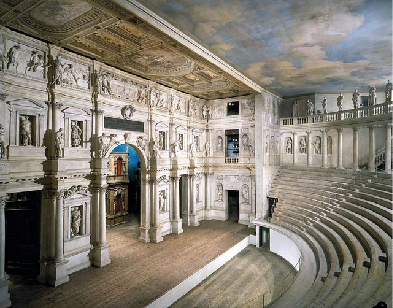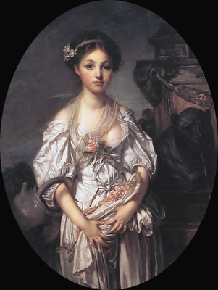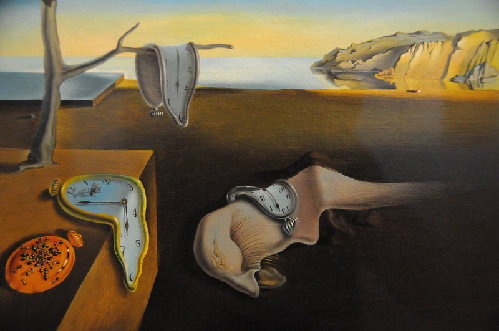Insight Journals Sept-Dec 2019
Jessica Jo-Tzu Yang
Prologue
We are constantly surrounded by art in our daily lives, and the overlaps, as well as relations between art forms are always in existence, and definitely not negligible. Often times, it is obvious that music is related to dance, and dance is connected to visual art, but what is the direct relation between music and visual art? How does music influence the creating of visual art? In what ways does visual art shape music making? Did the history of music and visual art develop in a similar or contrasting way? These are all questions that we will be closely examining through different periods of music and art. Both music and art have always been heavily influenced by society, so the characteristics of each period will also be a major subject as we investigate their cross-modalities.
As Alex Clay Hutchings says, “Art is how we decorate space; Music is how we decorate time;” I say, “The intersection between art and music is how we decorate history and life.”
Connection between Visual Art and Music
Tuesday, September 12, 2019
The idea of associating visual arts with music amazes me greatly. When people see the depiction of Piazza San Marco by Gentile Bellini, ceremonial music immediately comes to mind. And Gabrieli’s music would then be in connection without a doubt. When we go to a museum, in terms of tone, we associate bright and popping colors with lighter music, while darker representation is often associated with calm, and music that appears to be more heavy-hearted. Then in terms of the space being presented in visual arts, landscape portraits give off the spacious feeling, so grander and broader music comes to mind; then, on the other hand, artworks with more compacted objects appear to be connected to faster, or livelier music with more intensity.
Procession in St. Mark's Square by Gentile Bellini (1496)
This is extremely interesting to me because as a violinist here at Juilliard, I have observed that teachers often mention that we should imagine a picture or moving frames in our mind when we try to be expressive when playing. So, making the connection between visual art and music is actually so common in everyday life that people, even I myself, neglect this important form of synesthesia.
Interpretations in Visual and Performing Arts
Tuesday, September 17, 2019
As discussed in class, many artists have created artwork with Jesus’ last supper as their theme. Despite having the same subject and figures, all of the completed works look drastically different and include personal views from the artists which shows different interpretation. For example, Tintoretto’s and Da Vinci’s “Last Supper” convey the religious scene in a very different perspective. Tintoretto’s work is in a diagonal view, with a spot-light effect. It has an unearthly feeling because of the supernatural depiction; he portrayed the scene as “crowded”; but Da Vinci’s seems more stable and classical, with not a single extra thing presented; the whole work is balanced, but not repetitive.
I think this idea ties closely to music, because ninety percent of the music we play as classical musicians is all about interpretation. We create music from a piece of paper with notes on it. We are the ones that make the composition alive. In this case, everyone sees the paper and the notes the same way, but the feeling that people get out of the composition can be entirely different. The most controversial talk about style, would definitely concern Bach. Some people believe that Bach should be played in the Baroque-style, which includes lighter and shorter bow length, and with more release in each bow (due to the kind of bow they use during the period). However, others believe that playing Bach in the Baroque-style is old-fashioned, and new generations should incorporate a more Romantic way of playing it. These kind of opposite ideas are then the reason why personal preference plays such a big role in performing arts.
Cecilia Bartoli
Tuesday, September 20, 2019
The Teatro Olimpico, designed by Andrea Palladio
The Teatro Olimpico, designed by Andrea Palladio
To take a closer look at the Teatro Olimpico, which was designed by Andrea Palladio and constructed in 1580-1586, we listened to Cecilia Bartoli’s performance in 1998 of Handel’s Lascia la Spina as well as Vivaldi’s Agitata da due Venti in the theater, and I’m completely blown away by everything I saw and heard. The theater itself is gorgeous and mesmerizing. The illusionist painting on the stage gives the whole space an even more holy and Godly feeling. It gave the audience a feeling of being outdoors instead of being contained in a hermetic space. But what really inspired me was Bartoli’s performance… Her Lascia la Spina gave me chills and goosebumps. As a musician, this is the level of performance I wish to achieve one day. She used no extra gestures or movements, and her pure voice was almost in an unflawed condition with so much emotion presented that it draws the audience into her journey immediately, more importantly – throughout the whole piece. I hope one day I can touch people’s hearts with the sound of my violin, and make them feel the way I felt.
Moreover, her performance of Agitata da due Venti was just flawless and impeccable. Everything, from technique to musicality, was just truly inspiring! Even with the virtuosic singing technique that is required, she did it with so much ease and with so much expression. Her whole performance really gave me so many new perspectives on watching a great artist performing a nearly perfect performance in a magnificent theater.
Mannerism & Modern Art?
Friday, September 27, 2019
We discussed Mannerism in the Late Renaissance era as the period where virtuosity is brought to the top, making art deliberately weird and distorted to express individualism and to reflect the troubles of the time. Using Parmigianino’s Madonna with the Long Neck (1535-1540), the originally peaceful, symmetric, balanced and elevated image is portrayed in a way that makes the audience uncomfortable. From the Madonna’s facial expression to her body proportion; and from the child’s position to his size, everything looks distorted. Even the angels don’t look holy; they look just like regular people. A possible explanation for this piece of virtuosic work is the rebirth of antiquity emphasizing the improvement of religion.
Infinity-Nets [TOWZ] by Yayoi Kusama, (2006)
When tying this painting to modern art, the first artist that comes to mind is Yayoi Kusama. Kusama continued her creation of art even when she was mentally ill and in an emotionally unstable condition. Even though she went to Kyoto School of Arts and Crafts at one point, she never followed the traditional path of what she learned in the institution, a Japanese painting style called nihonga. Instead, Kusama was fond of and inspired by the American Abstract Expressionism, so she moved to New York City in 1958 to follow her dream path. Her most sought-after paintings are the "Infinity Nets." Kusama describes those as paintings “without beginning, end, or center. The entire canvas would be occupied by monochromatic net. This endless repetition caused a kind of dizzy, empty, hypnotic feeling.” And to someone who suffers from trypophobia, this painting definitely conveys Kusama’s intention which triggers the weakest part in me, makes me extremely uncomfortable, and gives me goosebumps. Connecting this back to Mannerism during the Renaissance, these virtuosic and distorted artworks were intentionally made, proving that art does not need to be beautiful to have an impact.
Hidden Meaning in Art
Tuesday, October 8, 2019
Bacchus by Caravaggio (1595)
Caravaggio often took everyday people as the subject of his art and he took advantage of the idea and technique of chiaroscuro, which is the treatment of light and shade to create dramatic effects. In his work “Bacchus,” dated between 1597-1598, he portrays a muscular but youthful boy dressed as the ancient god of wine in a classical fashion. However, the robe that he’s wearing is not tidy, his eyes do not seem energetic, and fruits in the basket and on the table are mostly half-rotten. These specific details made scholars try to establish this work as an allegory, believing that Caravaggio is trying to convey the idea that if you don’t believe in something long-lasting, but rather indulge in pleasures, just like those fruits in “Bacchus,” it’ll rot and disappear one day.
This idea of having a hidden meaning in art made me think of Shostakovich’s 5th Symphony, composed between April and July 1937. He composed it to satisfy Stalin after his 4th symphony was banned from being performed because it did not comply with Stalin’s request for Soviet composers to write music that was joyful and optimistic. Instead he expressed his terror and frustration through his music. Shostakovich received a threatening personal letter from Stalin ordering him to compose triumphant music that glorifies the Soviet Union. So in the finale of the 5th Symphony, Shostakovich included large sections for brass instruments, especially trumpets, and also kettle drum in D major (the same key as Beethoven’s 9th Symphony, the "Ode to Joy"). Stalin loved it; however, the music doesn’t actually represent triumph, but forced rejoicing instead. This was symbolized by the strings and woodwinds playing repeated A’s at the end of the final movement with metronome number marked half the normal sounding speed. He said it himself, “The rejoicing is forced, created under threat. It’s as if someone were beating you with a stick, saying ‘Your business is rejoicing, your business is rejoicing’, and you rise up, shaky, and go marching off, muttering, ‘Our business is rejoicing.’”
Allegory In Art
Tuesday, November 12, 2019
I mentioned in one of my previous entries that Caravaggio’s work “Bacchus,” dated between 1596-1598, portrays a muscular but youthful boy dressed as the ancient god of wine in a classical fashion, but with specific details that hints at an allegory. I believe that Caravaggio is trying to convey the idea that if you don’t believe in something long-lasting, but rather indulged in pleasures and only strive for things of the flesh, just like those fruits in “Bacchus,” they will rot and disappear one day. Now I will compare “Bacchus” to John-Baptiste Greuze’s “Broken Pitcher” (1771). In this work, a young girl with blue eyes, light hair, pink cheeks, very red lips, and dressed in white, shows the innocence of a child. However, on her arm she carries a pitcher which is broken though she has not discarded it, and her clothing is torn apart and she is not properly dressed. This is Greuze’s way of expressing the allegory of the young girl’s broken hymen and the loss of her virginity and the fear of telling her parents what has happened. Her hands are weakly guarding herself, but it already seems too late.
The Broken Pitcher by John-Baptiste Greuze (1771)
Caravaggio, being a late Renaissance and Baroque painter, uses the extreme technique of chiaroscuro, the treatment of light and shade to create dramatic effects. In “Bacchus,” the small details of the fruits that are hinting at the allegory are almost hidden due to the strong presence of the boy and the interesting color choices that Caravaggio chose to paint in. On the other hand, Greuze, being a painter that disapproved of the nobility and stood on the dark side of the Rococo period, painted “Broken Pitcher” in a way that the audience would focus on the young girl immediately with the spotlight-lighting effect. His allegory is also straightforward and exposed, as if he intentionally wanted everyone to notice and wasn't trying to hide anything. He also doesn’t use much color in this painting, instead, he chose to use different shades of each color to create the authenticity and dramatic effect.
A Color Symphony
Tuesday, November 26, 2019
Symbolism brings together different art forms that create a suggestive delivery and vagueness in meaning. Poets such as Charles Baudelaire (1821-1867), Paul Verlaine (1844-1896), and Arthur Rimbaud (1854-1891), are all prominent figures in Symbolist art. In music, Debussy and Ravel are the two composers that stand out with their aesthetic movements in their compositions.
Relative to this poetry, the Color Symphony (1921-22) by Arthur Bliss comes to mind. Just by looking at the title, this is definitely a piece with metaphorical synesthesia which incorporates visual art into music. Bliss was an English composer and conductor. What inspired him to compose this piece was when he came across a book that talks about colors associated with certain emotions and meanings. Through this, he attempted to write a symphony where he gives each movement a character corresponding to these meanings. The first movement is “Purple,” where his notes relate to the war has haunted him for years (his musical training was cut short by the First World War, in which he served with distinction in the army). Purple – the color of mourning. This movement is slow and majestic in pace, which matches the atmosphere of a coronation with that of a funeral. The second movement is “Red,” a glittering, spiky and percussive scherzo. Red – the color of courage. This movement is an idea that life goes on with tremendous force, with Bliss using the brass section to portray violence and aggressiveness. “Blue” being the third movement is the color of deep water, loyalty and melancholy. Bliss instructs that it should be “gently flowing,” depicting a scene of the water lapping against a moored boat or a pier. The last movement is “Green.” The color green suggests victory, hope, youth, spring. This movement includes a double fugue reminiscent of Schoenberg to give the triumphant finish.[1]
Symbolism/Impressionism vs. Surrealism/Cubism
Tuesday, December 3, 2019
While discussing Symbolism versus Impressionism in class, we compared Puvis de Chavannes’s “Hope” (1872) to Monet’s “The River” (1868). Puvis’s Symbolist style creates a dreamier atmosphere within the artwork - the subjects are poetic. Monet’s impressionistic style evokes the audiences emotion through a more realistic portrayal despite being blurry and indistinct. The intention of using strokes and colors to show movement through the artist’s eyes instead of directly in art is essential.
With these comparisons in mind, I had the idea of comparing Surrealism and Cubism in art. Surrealism puts the unconscious mind into art, resulting in dreamlike and often bizarre imagery across endless media,[2] which involves the act of automatic or uncensored recording of the thoughts and images that emerge into an artist’s mind. One of the most famous examples of Surrealism is “The Persistence of Memory” (1931) by Salvador Dalí. This work shows several soft melting pocket watches which are an unconscious symbol of the relativity of space and time, expressing the thought that time is not rigid and everything is destructible. However, the whole composition seems weird because of the way different subjects were put together in the frame. The background is a desert-like surrounding; the left portion of the painting shows a table with melting watches and a hot water rubber bag with ants crawling all over, then a duck-like animal lying dead in the right portion of the painting. These combinations are odd and do not seem to belong in the same picture. On the other hand, Cubism is the idea of bringing different views of subjects together in the same picture, resulting in paintings that appear fragmented and abstracted. Like Surrealism, Cubist art is not meant to look peaceful and harmonious, it is purposely created to evoke emotions of the audiences through the trick of eyes by showing different dimensions of the subject[3]. But unlike Surrealistic arts where multiple concepts and subjects are inserted into the frame, Cubism focuses on one subject or idea. For example: Picasso’s “Three Musicians”(1921). On the left he shows a clarinet player; in the middle, a guitar player and on the right a singer holding sheets of music. However, it is almost impossible to tell them apart because their body parts are all mixed together and overlapping. This was Picasso’s way of analyzing the shapes of each subject and reinventing them on the canvas.
In short, both Surrealism and Cubism force the viewers to participate with the artist in order to make the artwork make sense, but in very different ways and using very different techniques.
The Persistence of Memory by Salvador Dalí (1931)
Three Musicians by Pablo Picasso (1921)
Footnotes
[1] Heffer, Simon. “Simon Heffer: Why A Colour Symphony Is Pure Bliss.” The Telegraph, Telegraph Media Group, 26 Jan. 2016
[2] https://www.theartstory.org/movement/surrealism/
[3] https://news.masterworksfineart.com/2018/10/31/pablo-picasso-and-cubism
Works Cited
Images sourced courtesy of ARTSTOR.
Copyright © 2020 Jessica Jo-Tzu Yang



![Infinity-Nets [TOWZ] by Yayoi Kusama, (2006)](https://images.squarespace-cdn.com/content/v1/5c5b3d197d0c917410a2b0ab/1583341121202-9PND8CAEHFVAQVL247CQ/Kusama.jpg)







